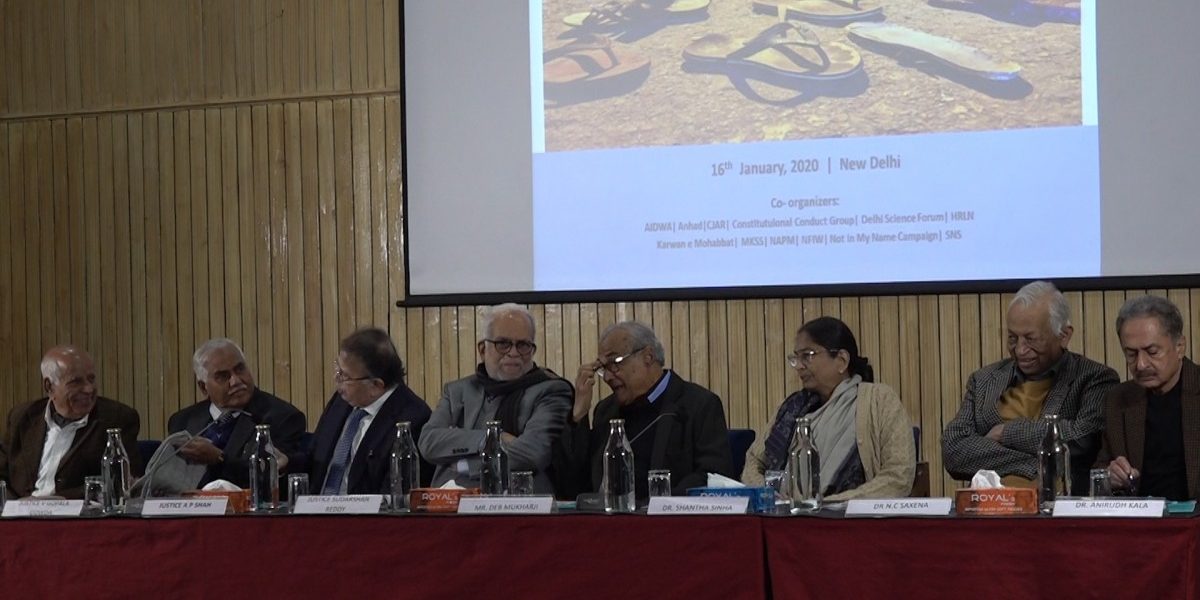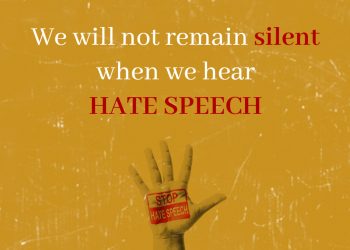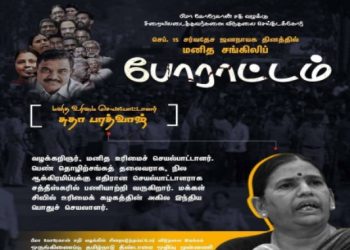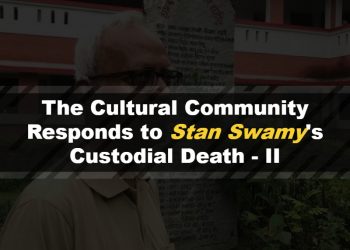On Thursday, January 16, a group of civil society organisations came together to hold a people’s tribunal on state action in Uttar Pradesh. Many instances of police brutality were reported in the BJP ruled state. These incidents took place following a wave of protests that hit the country after the upper house of the Parliament passed the Citizenship Amendment Bill on the night of December 9, 2019.
The programme was co-organised by AIDWA, Anhad, Constitutional Conduct Group, Delhi Science Forum, Human Rights Law Network, Karwan-e-Mohabbat, Mazdoor Kisan Shakti Sangathan, National Alliance of People’s Movements, National Federation of Indian Women, Not in my Name and Satark Nagrik Sangathan.
The following is the text of the finding of the jury, which comprised of Justice A P Shah, Justice Sudarshan Reddy, Prof Irfan Habib, Justice V Gopala Gowda, Dr Shantha Sinha, Dr NC Saxena, Mr Deb Mukherji, Chaman Lal and Dr Arvind Kala.

Introduction
As peaceful protests were organized around the country against the CAA, NRIC and the NPR, the state of Uttar Pradesh stands out for the intense harshness of the state action to crush the voices of dissent. There were many deeply troubling reports of the brutality and intensity of police action which followed, which led to the formation of this peoples tribunal to investigate the truth of the matter.
The jury of this People’s Tribunal is deeply worried and dismayed by the testimonies placed before it. It is convinced that the entire state machinery, led from the top, acted with grave prejudice and perpetrated violence targeting one particular community, the state’s Muslim population, and the social activists leading the movement.
The jury heard the testimonies of field workers, lawyers, human rights defenders, civil society activists, doctors, eyewitness accounts, and also looked at the videos of victims.
The following were the main findings of the Tribunal.
Police Violence:
The Jury found and concluded that the UP police has been guilty of inflicting enormous violence targeting the Muslim community, peaceful protestors, and not even sparing those were not involved in the protest. The police brutality included:
- apart from violence inflicted on protestors
- the arrest of and filing of false cases against innocent people
- the destruction of vehicles and property by entering people’s homes, as well as CCTV cameras
- the threats and intimidation of people picked up, against speaking the truth about what happened to any authority or to the media
- the communalised abuses against victims
- custodial violence even on minors
- firing and killing people without following the law
- preventing medical personnel from treating the injured, and threatening the injured against accessing medical care
The complaints of the victims about police brutality, violence and destruction of property were either not filed or filed incorrectly. On the other hand, thousands of FIRS were filed against unnamed persons on accusation that protestors had become violence with the intention of continued harassment and intimidation.
Role Political Executive and State Administration
The jury found that political and administrative leadership has failed to control the widespread atrocities caused by the police. In several instances, the jury have observed that senior leadership such as the Chief Minister directed the Police to use the strongest force against protesting citizens by using words like badla or revenge.
The Jury concludes that the state administration, through arbitrary and extensive imposition of Section 144 CrPC in several districts, shutting down of internet services, violated the citizens rights and facilitated police violence.
Role of Medical Officers:
Several people testified that hospital authorities and medical officers denied emergency medial care to even seriously injured victims. It was suggested that this was done allegedly under pressure from the police and state administration. This has clearly been in violation of the Article 21 of the Constitution and the various decisions of the Supreme Court and international treaties to which India is signatory, finally the Hippocratic oath of medial professionals. Such denial does not take place even during war!
Impact on Survivors:
The Jury takes note of the looming anxiety within the families of those affected by this violence.
These instances of violence, abuse, and destruction of homes by the police have resulted in absolute fear and trauma in the community. It is important to understand that when the state is the perpetrator itself, there is no sense of security for those affected. It appears that there is no health care or legal help accessible to victims in these difficult and testing times leaving them at a state of acute depression and or anxiety. Chances are that there will be large scale Post Traumatic Stress Disorder in this population unless addressed.
The Jury further acknowledges the immediate need for adequate mental health support for those affected by this crisis.
Attacks on Human Rights Defenders
The Jury found several activists, journalists human rights defenders and lawyers who stood up to injustice were being persecuted, intimidated, harassed and tagged as ‘urban naxals’, anti -nationals. The Jury condemns the arbitrary arrests of the human rights activists and defenders.
Issues around Juveniles and Minors
The Jury is of the opinion that the UP Police and State Administration have violated every principle enshrined in the Juvenile Justice Act, 2015. Every single agency and mechanism that could have come to the rescue of children failed to do its duty. It also reveals that even the best of laws cannot fulfill its purpose if the executive machinery does not wish to see it being implemented well and judiciously.
Recovery of costs by the state
The jury found that the police has been arbitrarily issueing notices to people for recovery of costs of damage to public property allegedly caused by them without specifying any details. Obviously, this cannot be done without establishing the culpability of the person in a court of law. These are intimidatory and illegal tactics being employed by the police. In fact, there is considerable evidence to show that the police itself indulged in destruction of private property of innocent people.
Concluding remark:
The state of affairs in UP shows a complete collapse of rule of law. In fact, the very state administration that is charged with protecting the rule of law is perpetrating violence upon its own people.




